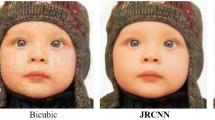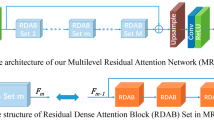Abstract
Convolutional neural networks (CNNs) have recently made impressive results for image super-resolution (SR). Our goal is to introduce a new image SR framework rely on a CNN. In this paper, the input image is decomposed into luminance channel and chromatic channels. A designed network based on a residual dense network is introduced to extract the hierarchical features from luminance part. The bicubic interpolation is simply used to upscale low resolution (LR) chromatic channels. However, this step degrades the chromatic channels. To tackle this issue, the SR reconstructed luminance channel is applied as the reference image in guided filters to promote the interpolated chromatic channels. Guided filters technique has ability to retain sharp edges and fine details from the reference image and carry them to the target images. Extensive experiments on several commonly used image SR testing datasets demonstrate that our framework has the ability to extract features and outperforms existing well-known techniques for image SR by LR image into the high resolution (HR) image efficiently.














Similar content being viewed by others
References
Abbass MY, Kim HW (2018) Blind image separation using pyramid technique. EURASIP Journal on Image and Video Processing 2018 (1)
Abbass MY, Kim H, Abdelwahab SA, Haggag SS, el-Rabaie ESM, Dessouky MI, el-Samie FEA (2019) Image deconvolution using homomorphic technique. SIViP 13:703–709. https://doi.org/10.1007/s11760-018-1399-1
Abualigah L (2020) Multi-verse optimizer algorithm: a comprehensive survey of its results, variants, and applications. Neural Comput & Applic 32:12381–12401. https://doi.org/10.1007/s00521-020-04839-1
Abualigah L, Diabat A (2020) A novel hybrid antlion optimization algorithm for multi-objective task scheduling problems in cloud computing environments. Cluster Comput. https://doi.org/10.1007/s10586-020-03075-5
Abualigah LM, Khader AT, Hanandeh ES (2018) Hybrid clustering analysis using improved krill herd algorithm. Appl Intell 48:4047–4071. https://doi.org/10.1007/s10489-018-1190-6
Alam MS, Kwon K-C, Alam MA, Abbass MY, Imtiaz SM, Kim N (2020) Trajectory-based AirWriting recognition using deep neural network and depth sensor. Sensors 20:376
Bevilacqua M, Roumy A, Guillemot C, Alberi Morel M L (2012) Low-complexity single-image super-resolution based on nonnegative neighbor embedding. In BMVC
Chen Y, Tan H, Zhang L, Zhou J, Lu Q (2019) Hybrid image super-resolution using perceptual similarity from pre-trained network. J Vis Commun Image R 60:229–235
Dong C, Loy CC, He K, Tang X (2016) Image super-resolution using deep convolutional networks. IEEE Trans Pattern Anal Mach Intell 38(2):295–307
Dong C, Loy CC, Tang X (2016) Accelerating the super-resolution convolutional neural network. In: Proceedings of the European Conference on Computer Vision, pp 391–407
Freeman WT, Jones TR, Pasztor EC (2002) Examplebased super-resolution. IEEE Comput Graph Appl 22(2):56–65
Greeshma MS, Bindu VR (2020) Super-resolution Quality Criterion (SRQC): a super-resolution image quality assessment metric. Multimed Tools Appl. https://doi.org/10.1007/s11042-020-09352-0
Huang JB, Singh A, Ahuja N (2015) Single image super-resolution from transformed self-exemplars In. IEEE Conference on Computer Vision and Pattern Recognition, pp 5197–5206.
Huang Y, Li J, Gao X, He L, Lu W (2018) Single image super-resolution via multiple mixture prior models. IEEE Trans Image Process 27(12):5904–5917
Tak Wai Hui, Change Loy Chen, Xiaoou Tang (2016) Depth map super-resolution by deep multi-scale guidance. In: ECCV, pp 353–369.
Khan A, Sohail A, Zahoora U et al (2020) A survey of the recent architectures of deep convolutional neural networks. Artif Intell Rev 53:5455–5516. https://doi.org/10.1007/s10462-020-09825-6
Kim KI, Kwon Y (2010) Single-image super-resolution using sparse regression and natural image prior. TPAMI 32(6):1127–1133
Kim J, Lee JK, Lee KM (2016) Accurate image super-resolution using very deep convolutional networks. In: Proceedings of the IEEE Conference on Computer Vision and Pattern recognition. Las Vegas, pp 1646–1654
Kim J, Lee JK, Lee KM (2016) Deeply-recursive convolutional network for image super-resolution. In: Proceedings of the IEEE conference on computer vision and pattern recognition, pp 1637–1645
Lai W-S, Huang J-B, Ahuja N, Yang M-H (2017) Deep Laplacian pyramid networks for fast and accurate super-resolution. In: Proceedings of the IEEE Conference on Computer Vision and Pattern Recognition, pp 624–632
Ledig C, Theis L, Huszar F, Caballero J, Cunningham A, Acosta A, Aitken AP, Tejani A, Totz J, Wang Z, Shi W (2017) Photo-realistic single image super-resolution using a generative adversarial network. In: Proceedings of IEEE conference on computer vision and pattern recognition. CVPR, Honolulu, pp 105–114
Yijun Li, Jia Bin Huang, Narendra Ahuja, Ming Hsuan Yang (2016) Deep joint image filtering. In: ECCV, pp 154–169
Lim B, Son S, Kim H, Nah S, Lee KM (2017) Enhanced deep residual networks for single image super-resolution. In: Proceedings of IEEE conference on computer vision and pattern recognition. CVPR, Honolulu, pp 1132–1140
Martin C, Fowlkes D, TalJ Malik (2001) A database of human segmented natural images and its application to evaluating segmentation algorithms and measuring ecological statistics, Computer Vision, 2001. ICCV 2001. Proceedings. Eighth IEEE international conference on, vol 2, pp. 416–423
MohammadAbualigah L, TajudinKhader A, SaidHanandeh E (2018) A combination of objective functions and hybrid krill herd algorithm for text document clustering analysis. Eng Appl Artificial Intell 73:111–125. https://doi.org/10.1016/j.engappai.2018.05.003
MohammadAbualigah L, TajudinKhader A, SaidHanandeh E (2018) A new feature selection method to improve the document clustering using particle swarm optimization algorithm. J Computation Sci 25:456–466. https://doi.org/10.1016/j.jocs.2017.07.018
Nasrollahi H, Farajzadeh K, Hosseini V, Zarezadeh E, Abdollahzadeh M (2020) Deep artifact-free residual network for single-image super-resolution. SIViP 14:407–415. https://doi.org/10.1007/s11760-019-01569-3
Haoyu Ren, Mostafa Elkhamy, Jungwon Lee (2017) Image super resolution based on fusing multiple convolution neural networks. In: CVPR, pp 1050–1057
Shi W, Caballero J, Ledig C, Zhuang X, Bai W, Bhatia K, Antonio M, de Marvao SM, Dawes T, O’Regan D, Rueckert D (2013) Cardiac image super-resolution with global correspondence using multi-atlas patchmatch. In: Proceedings of the International Conference on Medical Image Computing and Computer-as- sisted Intervention. Springer, pp 9–16
Singh A, Ahuja N. (2014) Super-resolution using sub-band self-similarity. In ACCV
Singh A, Singh J (2020) Survey on single image based super-resolution — implementation challenges and solutions. Multimed Tools Appl 79:1641–1672. https://doi.org/10.1007/s11042-019-08254-0
Tai Y, Yang J, Liu X (2017) Image super-resolution via deep recursive residual network. In: Proceedings of the IEEE Conference on Computer Vision and Pattern Recognition, pp 3147–3155
Timofte R, De V,Gool LV (2013) Anchored neighborhood regression for fast example-based super-resolution. In: Proc. IEEE Int Conf Comput Vis, Sydney, pp 1920–1927.
Timofte R, De Smet V, Van Gool L (2014) A+: Adjusted anchored neighborhood regression for fast super-resolution in Proc IEEE Asian Conf Comput Vis, pp 111–126
Timofte R, Agustsson E, Gool LV, Yang M-H, Zhang L, Lim B, Son S, Kim H, Nah S, Lee KM, et al. (2017) Ntire challenge on single image super-resolution: methods and results. In: Proceedings of the IEEE Conference on Computer Vision and Pattern Recognition Workshops (CVPRW). IEEE, pp 1110–1121
Tong T, Gen L, Xiejie L, Qinquan G (2017) Image super-resolution using dense skip connections. In: Proceedings of the IEEE International Conference on Computer Vision, pp 4 809–4 817
Tsai RY, Huang TS (1984) Multiframe image restoration and registration. In: Proceedings of Advances in Computer Vision and Image Processing, pp 317–339
Veit A, Wilber MJ, Belongie S (2016) Residual networks behave like ensembles of relatively shallow networks. In: Advances in Neural Information Processing Systems, pp 550–558.
Wang Z, Liu D, Yang J, Han W, Huang T (2015) Deep networks for image super-resolution with sparse prior. In: Proceedings of the IEEE International Conference on Computer Vision, pp 370–378
Yang J, Wright J, Huang TS, Ma Y (2008) Image super-resolution as sparse representation of raw image patches. In: Proceedings of IEEE Computer Society Confer- ence on Computer Vision and Pattern Recognition. CVPR, Anchorage
Zagoruyko S, Komodakis N (2016) Wide residual networks, arXiv preprint, arXiv: 1605.07146
Zeyde R, Elad M, Protter M (2010) On single image scale-up using sparse-representations, In: Proceedings of International Conference on Curves and Surfaces Avignon, pp 711–730.
Zhang Q, Chen B, Lu X, Xia Q (2018) Super-resolution of single multi-color image with guided filter. J Vis Commun Image R 58:277–284. https://doi.org/10.1016/j.jvcir.2018.11.040
Zhang K, Zuo W, Zhang L, (2018) Learning a single convolutional super-resolution network for multiple degradations. In: Proceedings of the IEEE Conference on Computer Vision and Pattern Recognition, pp 3262–3271
Zhang Y, Zhang Y, Zhang J, Xu D, Fu Y, Wang Y, Ji X, Dai Q 2019 Collaborative Representation Cascade for Single-Image Super-Resolution. IEEE Trans Syst Man Cybernetics: Syst 49(5)
Zhao F, Si W, Dou Z (2019) Image super-resolution via two stage coupled dictionary learning. Multimed Tools Appl 78:28453–28460. https://doi.org/10.1007/s11042-017-5493-0
Acknowledgments
This research was supported by the Korea Government, under the ITRC (Information Technology Research Center) support program (IITP-2020-2015-0-00448) and Grand Information Technology Research Center support program (IITP-2020-0-01462), supervised by the IITP (Institute for Information & communications Technology Promotion).
Author information
Authors and Affiliations
Corresponding author
Additional information
Publisher’s note
Springer Nature remains neutral with regard to jurisdictional claims in published maps and institutional affiliations.
Rights and permissions
About this article
Cite this article
Abbass, M.Y., Kwon, KC., Alam, M.S. et al. Image super resolution based on residual dense CNN and guided filters. Multimed Tools Appl 80, 5403–5421 (2021). https://doi.org/10.1007/s11042-020-09824-3
Received:
Revised:
Accepted:
Published:
Issue Date:
DOI: https://doi.org/10.1007/s11042-020-09824-3




